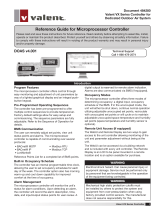
BACnet Integration Guide – DOAS_08.000 Rev 2 Page | 4
Object Variable Description Active Text Inactive Text
Controller Provided Sequences – Unoccupied Mode
When the unoccupied mode of operation is set to night setback temperature, normal operation with unoccupied setpoints, or recirculation with
unoccupied setpoints, the following setpoints control unoccupied heating and cooling operation. If night setback is selected as the Unoccupied Mode
of operation, the reset mode will not be available to change at the controller and should be set to Space Reset(2).
IV-2 Temperature_Reset_Mode_Unoccupied Commands the reset mode during occupied
operation. 1 = No Reset, 2 = Space Reset
3 = Return Reset, 4 = Outside Reset
AV-3 Temperature_Setpoint_Unoccupied
Sets the temperature setpoint based on mode
of operation (space setpoint, return setpoint or
supply setpoint).
Not applicable for outside reset.
Real, Default = 70°F
*Min = 50°F; Max = 100°F
AV-4 Temperature_Heat_Cool_Deadband_Unoccupied
Heat/Cool Setpt Deadband when Space or
Return reset control is active.
Unooc Clg Setpt = Temp Setpt Unocc +
(Deadband Unocc)/2
Unocc Htg Setpt = Temp Setpt Unocc +
(Deadband Unocc)/2
Real, Default = 20°F
*Min = 0.5°F; Max = 40°F
[Space/Return Heating = 60°F,
Space/Return Cooling = 80°F]
BMS Controlled Sequences
BMS control over reset write to temp setpoint and have mode in No reset.
* Typical range for standard configuration unit, please verify at point min and max properties.
DEHUMIDIFICATION OPERATION SETPOINTS
Object Variable Description Active Text Inactive Text
Dehumidification Setpoints
The unit controller will enter occupied dehumidification mode when the dehumidification trigger(s) is met. During dehumidification mode, the cooling
system is controlled to maintain the cooling coil leaving air temperature setpoint while the hot gas reheat system (if installed) reheats the air to
maintain the active supply air temperature setpoint. For units with space or return humidity sensors, the controller may also actively reset the cooling
coil temperature setpoint between minimum and maximum values to maintain the target space/return dehumidification setpoint (% RH).
Note: By default, unoccupied dehumidification mode is not active unless a trigger to enter the mode is selected at the unit controller since most
spaces do not have an unoccupied dehumidification load.
AV-5 Cooling_Coil_Setpoint_Min Primary Cooling Coil Leaving Air Setpoint Default = 50°F
*Min = 46°F; Max = 80°F
AV-6 Cooling_Coil_Setpoint_Max Maximum Coil Leaving Setpoint if cooling coil
rest strategy is used. Default = 55°F
*Min = 46°F; Max = 80°F
AV-7 Dehumidification_Setpoint Dehumidification Setpoint. %RH for Space or
Return control Default = 55% RH
Min = 0%; Max = 100%
AV-11 Unoccupied_Dehumidification_Setpoint Unoccupied Dehumidification %RH Setpoint Default =60% RH
Min = 0%; Max = 100%
* Typical range for standard configuration unit, please verify at point min and max properties.
AIRFLOW OPERATION SETPOINTS
Object Variable Description Active Text Inactive Text
Airflow Setpoints
Airflow operation of supply fan, exhaust fan, and mixing dampers may use setpoints from duct pressure, space pressure, CO2 sensors, or airflow
measuring stations to properly control airflow in an application. The Outside Air Damper Minimum Setpoint Occupied applies to all units with
modulating outside air dampers. The setpoint is used to establish an absolute minimum position for ventilating the space while allowing other control
modes to open the damper further as necessary. Outdoor and recirculating air dampers operate inversely using the same signal.
AV-14 Supply_Fan_CFM_Setpoint Supply Fan CFM Setpoint Default = Job Specified CFM
Min = 0 cfm; Max = 999,999 cfm
AV-15 Exhaust_Fan_CFM_Setpoint Exhaust Fan CFM Setpoint Default = Job Specified CFM
Min = 0 cfm; Max = 999,999 cfm
AV-16 OAD_CFM_Setpoint OAD CFM Setpoint Default = Job Specified CFM
Min = 0 cfm; Max = 999,999 cfm
AV-21 Return_Duct_Static_Pressure_Setpoint Return Duct Static Pressure Setpoint Default = -2.0”wc
Min = 0.0”wc; Max = -5.0”wc
AV-22 Space_Static_Pressure_Setpoint Space Static Pressure Setpoint Default = 0.05”wc
Min = -0.5”wc; Max = 0.5”wc
AV-23 Supply_Duct_Static_Pressure_Setpoint Supply Duct Static Pressure Setpoint Default = 1.0”wc
Min = 0.0”wc; Max = 5.0”wc
AV-24 Space_CO2_Setpoint Space CO2 Setpoint Default = 1,000 ppm
Min = 0 ppm; Max = 5,000 ppm
AV-25 Outside_Air_Damper_Minimum_Setpoint_Occ Outside Air Damper Minimum Setpoint Occupied Default = 35%
Min = 0%; Max = 100%













